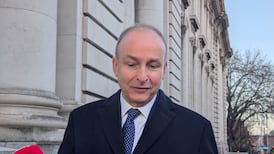President Higgins joined representatives of the British and Belgian royal families and European heads of state in laying a wreath to the dead of the First World War at a graveyard near Mons in Belgium yesterday evening.
French president François Hollande used the occasion to point to the lessons of history for today’s conflicts in Ukraine and Gaza and said “Europe has to take its responsibility to act, along with the UN. We cannot simply invoke a cult of memory, we have to take our responsibilities.”
In a strongly worded speech President Hollande referred to the violation of Belgian neutrality in two world wars but added: “I mentioned the neutrality, twice compromised, of Belgium, but today neutrality is no longer an option,
“How can we stay neutral when a people, not far from Europe, is fighting for its rights and territorial integrity? How to stay neutral when a civilian aircraft can be shot out of the sky? When there are civilian populations being massacred in Iraq, minorities being persecuted in Syria?
“When in Gaza a murderous conflict has been going on for over a month . . . we cannot stay neutral, we have an obligation to act,” he said.
In a moving ceremony on a day of commemorations to mark the centenary of the start of the war, President Higgins, King Philippe of Belgium, Prince William and prime minister David Cameron of Britain and German president Joachim Gauck laid flowers at St Symphorien cemetery where British, Irish and German soldiers are buried side by side.
President Higgins and his wife Sabina joined Prince William and wife Kate, the Duchess of Cambridge, in shaking hands with the relatives of Irish soldiers killed at the battle of Mons at the beginning of the first World War.
Among the relatives who met President Higgins and the Duke and Duchess were Maurice French and his son Patrick. Maurice is the nephew of Lt Maurice Dease of Coole, Co Westmeath, who was killed at Mons on August 23rd 1914.
The 25-year old Dease was in command of a machine gun section of the Royal Fusiliers who, although wounded, kept firing until all his men were killed.
The President also spoke to Rosiland Scothern, the grand daughter of Sgt Major Denis Walsh from Capoquinn in Co Waterford of the Royal Irish Regiment who was also killed on August 23rd.
Irish victims
More than 200 Irish soldiers died at Mons and 28 of them are buried at St Symphorien. The graveyard was laid out by the Germans in 1917 when they controlled that part of Belgium and soldiers from the German and British armies were interred side by side.
Most of the Irish buried at St Symphorien were members of the Royal Irish Regiment who came from all classes and from different parts of the country. Private Stephen Ryan was 33 years old and is described on his gravestone as the son of Timothy and Mary Ryan of Cashel, Co Tipperary, and the husband of Mary Ryan of the Green, Cashel.
Another member of the regiment buried there is Private James Collins from Waterford, just one of a number of Waterford men who died at Mons.
While the President participated in laying a wreath, Mrs Higgins took part in a ceremony involving the lighting of lanterns.
After the ceremonies Prince William and the Duchess escorted President and Mrs Higgins from the memorial where they signed two visitors books, one held by the Commonwealth War Graves Commission and the other by the City of Mons.
Liege ceremony
Earlier in Liege, President Higgins was one of 17 heads of state who participated in a moving ceremony at the Allied war memorial in the centre of the town which was attended by representatives of more than 80 countries.
There were speeches from King Philippe of Belgium, Prince William of Britain, Mr Hollande and Mr Gauck.
Prince William evoked Edith Cavell, the British nurse executed in Brussels who said, “I must have no hatred or bitterness towards anyone” as she faced a German firing squad.
“The events in Ukraine testify to the fact that instability continues to stalk our continent,” he said.
The part of the ceremony that excited most attention from the crowd gathered at the memorial was when a little girl, symbolising the passing on of remembrance to future generations, released a white balloon as a sign of peace and reconciliation.







